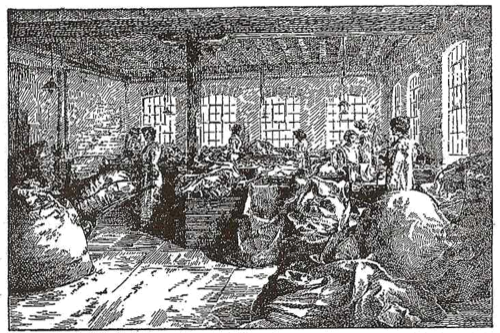Reference: [2] Handmade Paper in Tuckenhay Devon by Catherine Cox (1977)
|
The Rag House Rags come to the mill from all over Europe in large square bales, covered in sacking and banded with wire. When they arrive the rags are put through a thresher, this is a large wooden case, inside which is a roller in which iron-shod prongs revolve, above this lower moving wheel, fixed prongs stand, the prongs passing each other at every turn. This action unravels the rags, and knocks out some of the dust. From the thresher the rags are put into tall baskets and carried to the sorters, who sit in little cubicles behind each other. Material heaped on the left side of the sorter who knows by touch its composition is dealt with swiftly. Wool, silk, nylon and elastic are thrown into a corner to the right of the lattice, which is spread out in front of the sorter, this is an open wire-work sieve, through which a short, sharp upright knife is fixed, which is rather like a worn steel scythe. The cutting edge is turned away from the sorter, to it she brings the material and cuts it into six to eight inch lengths, after cutting, these lengths are thrown into one of the tall baskets which stands at the right side of the sorter. Tags, buttons, hooks, eyes & metal objects are cut off, and join the pile of wool etc., later to be burnt. |
The rags are then sent through trap doors and tumble down into a cutting machine, which cuts them into smaller pieces and carries them up to the rag house again on an endless ribbon to the magnet. Tumbling over two magnetized rollers, pins or any metal still retained in the rags are arrested and cling to the roller, as the cylinder turns, it becomes de-magnetised and falls in a place apart. The rags next go to the dusters, to be further dusted for twenty minutes, in open wire barrels, amid revolving wooden pegs. After this the rags are measured and put into huge metal boilers, each capable of holding a ton. Packed with rags, water and alkali, the boilers turn over and over, churning up the contents for two, four, five or even seven hours, dependent on the paper to be made. When boiled for the specified time, the boilers are blown, and after the clouds of steam have subsided, the boilers are refilled with cold water to cool the rags. The boilers are emptied by pulling out the rags with a hook, always upside down from the way they are filled. |
Reference: The Story of Handmade Paper (1924)

CUTTING RAGS AT LITTLE CHART